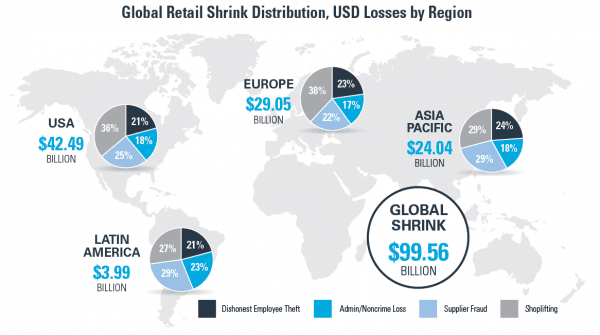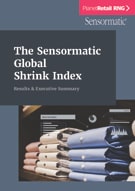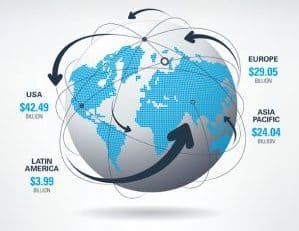In the United States and around the globe, shrink continues to be a challenge for retailers, especially as competition grows, profit margins constrict, and the availability of quality employees becomes increasingly limited. Retail companies in the US have been hit especially hard by shrink in the last five years, but technology is helping brands combat both internal and external theft.
Shrink cost US retailers an incredible $42.49 billion last year, according to the latest Sensormatic© Global Shrink Index study. US losses account for almost half of the total $100 billion in losses across all nations surveyed—a reality that has a significant impact on retail companies, employees, and shoppers alike.
The study found that US retailers are more likely to be plagued by external theft and shoplifting than internal theft. When comparing verticals, fashion and accessory retailers had the highest rate of shrink.

While the United States is in the top five countries in terms of investment in LP technology, the survey suggests there is room for improvement—even for those that already account for shrink in their business models.

“Controlling shrink is critical to the profitability of any retailer,” said Mike Keenan, CPP, CFI, LPC, managing director of retail loss prevention at TAL Global, an international security-consulting and risk management firm. “If you are able to reduce shrink, you’re bringing back real dollars to the bottom line.”
Tyco Retail Solutions commissioned the global shrink study, which was conducted in October 2017 by PlanetRetail RNG, a global retail intelligence and advisory firm. The online survey included more than 1,100 retail decision makers across four regions, fourteen countries, and thirteen retail segments. The retailers surveyed operate more than 229,000 stores and generated an estimated $1.56 trillion from 2017 into 2018, accounting for 80 percent of total retail sales worldwide.

The Global Leader
The impact of shrink on the US retail industry is substantial, in part because of the sheer size and value of the market in this country. The rate of retail shrink in the United States—1.85 percent—is only slightly above the global rate of 1.82 percent. However, since the United States is the largest global consumer market, its total losses are much higher than any other nation. In fact, America’s retail losses of $42.49 billion dwarf those of the countries with the next highest shrinkage values—China at $13.52 billion and the United Kingdom at $7.45 billion.

In the United States and globally, fashion and accessories stores experienced the highest rate of shrink. US fashion and accessory retailers reported losing 2.43 percent of sales to shrink, which was higher than the global average for that vertical at 1.98 percent. Experts indicate that stores selling clothing, shoes, and accessories likely are more attractive to thieves, since those products are generally worth more than other verticals, such as office equipment stores, which had the lowest shrink rate.

Kim Warne, vice president and chief marketing officer for Tyco Retail Solutions, explained that fashion merchandise is always in high demand, which is part of the reason why loss due to shrink in this vertical totaled more than $4 billion in 2017.
“By definition, fashion changes with the season, and these products are relatively higher priced and are highly brand specific,” Warne said. “The latest hot fashion items such as athletic shoes or purses being promoted are also the most likely to be stolen as the relative higher unit value makes them more attractive to thieves.”
The leading source of shrink will likely come as no surprise to US retailers. Nearly 36 percent of losses were reported to have come from external shrink, a figure that is slightly above the global average. Shoplifting was the main source of external losses at 51.5 percent. Return fraud was reported for 26 percent of external shrink cases, and organized retail crime (ORC) ranked third at 20 percent.
Internal shrinkage, including employee theft, was rated the second-highest source of shrink in the United States, at about 25 percent. Vendor and supplier losses totaled just over 21 percent of shrink, while administrative losses accounted for less than 19 percent.
Interestingly, the rates of shrink in certain US verticals ran contrary to those in the rest of the world. A prime example is the shrink rate for consumer electronics stores in the US (1.84%) versus the global rate (1.93%). This is a strong indication that US retailers have fully recognized the threat of shrink at high-value electronics stores and responded by installing effective loss prevention tools.
Factors Driving Retail Shrink
For many brands, effectively combatting shrink means first understanding the factors that drive it. The survey authors point to four factors driving increased shrinkage rates worldwide-growing urban population densities, difficult economic conditions, limited workforce pools, and the growth of online shopping.
In many countries and in areas throughout the US, expanding city populations and difficult economic conditions are conspiring to give employees and shoppers alike the motives for theft. Meanwhile, a shortage of retail workers and the proliferation of the Internet are creating greater opportunities for stealing products.
Keenan says the Internet has dramatically changed the landscape for external and internal thieves in the US. Perhaps that’s why employee theft of merchandise was the largest overall contributor of internal shrinkage losses at 41.6 percent, much greater than vendor and supplier losses and administrative losses. Meanwhile, shoplifting was by far the biggest source of external shrink in the US, accounting for more than 50 percent of such losses.
“When you think about what really drives external theft, it’s actually the capability to offload the product,” he said. “Prior to the Internet, the primary way you were able to sell large amounts of stolen merchandise was through a fence. The product would be sold in illegal stores, flea markets, and even out of personal homes. But now, all those products can be sold directly online. People can do it themselves. They don’t need a fence.”
Warne points out that the Internet has also created more of a market for ORC syndicates. “There’s increased pressure from organized retail crime because online channels are making it more profitable for these groups to sell stolen goods,” she said.
To make matters worse, ORC pays better in America. Survey respondents in the US reported that the average value of each ORC incident was more than $1,400, significantly higher than the value of ORC thefts globally.
The Role of Employees
The survey indicates that the tight labor pools that are challenging US retailers could be partially responsible for the uptick in shrink over the last five years.
Warne says limited access to high-quality employees and high turnover are making it more difficult to combat shrink. “Staffing in stores is declining, making it easier for potential thieves to take merchandise,” she said. “Plus, the US has more stores per capita than most other countries, and store footprints are larger.”
Keenan believes customer service is one key to combating external theft. “The number one deterrent to external theft is good customer service right now,” he said. “If you build a culture of good customer service, you deter people who are thinking about stealing. And you really have to integrate loss prevention into virtually everything you do.” Keenan recommends that brands incorporate loss prevention training into their customer service training.
He said a bit of situational awareness training-meaning learning those behaviors that indicate a customer may be thinking about shoplifting-can go a long way toward amplifying a store’s loss prevention capabilities. Meanwhile, he says, stores should educate employees on how shrink affects them directly in order to get their buy-in on loss prevention.
“In my mind, you need to teach the employee about why loss affects them,” he said. “If there is high loss, they won’t get as many hours because the company is less profitable. They may not get pay increases or bonuses either. People want to know, ‘What’s in it for me?’ Once they understand, you’ll have them as part of your LP team.”
However, for some retailers, it may not be enough to train employees on how to spot a potential shoplifter. Warne said that in the United States, omni-channel fulfillment is providing new opportunities for items to go missing. This means retailers also have to keep a closer eye on their own associates.

Impact of Shrink
As the sources of shrink evolve, how are retail losses impacting the industry and its customers?
Of course, when shrink gets out of control, it can hurt a retailer’s bottom line, particularly for smaller retailers that might not have the budget to “absorb” shrink. This can affect the company at large, as well as its employees who might see their hours cut or their bonuses and raises eliminated.
Theft can also impact customers, many of whom are gradually growing accustomed to being inconvenienced due to shrink, Keenan says.
“High shrink does cause inconvenience to the customer-having to remove security tags to try something on, not being able to access products without an associate’s help, or waiting in line longer as protective devices are removed or deactivated,” Keenan explained. “In the past, there was always this concern about how you were coming across to the customer. Too much security meant that maybe a store wasn’t safe. But I think our world is changing. Today, people understand. They see a security guard out front, and they appreciate it. I think today the need for security is understood by the customer, but it’s still an inconvenience.”
Meanwhile, as many brands work to cut costs to remain competitive with online retailers, some are hiring fewer employees. This can also be an inconvenience to the customer when they are looking for help or waiting in long lines to check out.
For those retailers being hit hardest by growing competition, Keenan emphasizes that shrink should be a priority for senior leadership—precisely because of the industry’s tight margins.
“When you think about low margins and the competitive landscape, if you do have high shrink, there is a profit opportunity if you can reduce it,” he said. “All retailers accrue for shrink based on past results. If you accrue at, say, 2 percent, and you come in at 1.5 percent, all those dollars go back to the bottom line. And so when you’re looking for dollars to save, shrink is a good place to find them.”
Keenan tells retailers to think of shrink as two-fold: If product is lost or stolen, it is not available to sell. You lose the cost of the product in shrink, but you also lose the margin. By protecting the merchandise, you can both reduce shrink and increase margin. “Controlling shrink impacts the business—and in so many ways,” he said. “If you don’t control shrink, it could be a pathway to going out of business.”
Technology as a Force Multiplier
As retailers grapple with these and other challenges, Warne and Keenan agree that technology is key for closing the gaps that exist around both internal and external shrink. Although the survey indicates that US retailers are doing a good job of protecting many high-value verticals, such as consumer electronics, there is always room for improvement.
When it comes to shoplifting, one of the top overall sources of shrink for US retailers, electronic article surveillance (EAS) is the leading tool and has been adopted by more than 92 percent of US respondents to the survey. After EAS, the next most popular is alarm monitoring, followed by access-control systems, exception-based reporting, and CCTV.
Facial recognition was listed as the least popular loss prevention tool among US retailers, followed by RFID and public-view monitors.
The fact that US retailers struggle more than their counterparts in other countries with external shrink suggests that they may be able to close the gap by embracing some loss prevention tools, such as RFID, that are still being underutilized.
In the US, the RFID adoption rate of 76.5 percent is lower than in any other country surveyed. Part of the reason might be the fact that US retailers tend to use RFID more for loss prevention and asset protection, while for the rest of the world’s retailers, inventory tracking and visibility are the dominant use case.
Keenan believes that RFID simply hasn’t reached the cost-effective “breaking point” that other tools have. “I believe eventually all retailers will have RFID,” he said. “But you have to consider the cost of the tags and readers. Adding a cost to every item is not something that any company takes lightly. There must be an ROI.”
Keenan says the price of RFID tagging needs to fall before it reaches widespread adoption in the US. Advances in technology may spur that process, he says, if RFID readers can, for example, be developed to provide more accurate, consistent tracking of product.
Keenan and Warne both agree that public-view monitors can be a powerful loss prevention tool for retailers of all sizes. Smaller retailers in particular are challenged to prevent shrink with relatively few associates on the store floor, which creates greater opportunities for shoplifting, associate theft, and sweethearting.
“Technology becomes critical for these [smaller] merchants,” Warne said. “Electronic public-view monitors act as a visual deterrent, keeping an eye on stores when an associate isn’t immediately on hand. At the same time, retailers are turning to lower-cost, cloud-based, remote video monitoring and analytics tools for 24/7 coverage to efficiently augment their current security strategy.”
Keenan says “reverse” public-view monitors—where the screen displays the point of view of a loss prevention professional—can be even more impactful. This is especially true for experienced thieves who may doubt that a store’s cameras are working or being monitored.
Meanwhile, US retailers also fall below the global average of merchandise tagged with EAS tags, both by the manufacturer or supplier and in-store. For retailers that are struggling to keep shrink manageable, upping their EAS tagging might be an easy, cost-effective way to minimize both internal and external theft.
Warne points out that EAS will only become more high tech in the coming years in response to more sophisticated techniques being used by shoplifters and ORC groups. For example, EAS source tagging will mean goods arrive tagged and ready for merchandising, and smarter EAS will only alarm when tagged items exit the store. In addition, EAS systems are now being integrated with video to provide real-time loss-event validation, alerts, and responses—rather than simply showing footage of an event that is already occurred. As thieves become savvier, retailers are deploying advanced tools and features beyond EAS that help detect and investigate theft. For example, as described in a feature article in the January-February 2018 edition of LP Magazine, Rite Aid is using the power of social media and crowdsourcing to get the public to help track down robbery and shoplifting suspects.
And Warne says more retailers are starting to leverage LP analytics through tools such as cloud-based shrink management as a service (SMaaS) platforms. These systems show retailers where spikes in organized crime are happening, so they can proactively prepare and even prevent ORC crime from flourishing.
Looking Ahead
While the sheer cost of US retail shrink may seem daunting, Warne points out that it’s simply part of the business. “As long as there are retailers, we will have retail loss,” she said. The trick for retailers is minimizing the losses.
As thieves become more sophisticated in their tactics, retailers have an opportunity to respond in kind. For both nationwide brands and local mom-and-pop stores, loss prevention technology can serve as a force multiplier, deterring and detecting theft in both new and tried-and-true ways. In today’s challenging retail landscape, these tools might be the difference between failure and success.

[SIDEBAR] Read the Full Sensormatic Global Shrink Index Report
“The Sensormatic© Global Shrink Index benchmarks retailer performance globally and sheds light on other factors affecting loss prevention. Knowing the state of shrink helps retailers better assess the challenges and solutions to make merchandise secure yet accessible for a better customer experience,” said Catherine Walsh, senior vice president and general manager of Tyco Retail Solutions.
The statistics contained in this report highlight the magnitude of shrink’s impact on retail and affords the opportunity to dive deeper into the sources of shrink, particularly in the US, as well as the loss prevention tools to help combat loss. To view the full report’s findings, visit shrinkindex.sensormatic.com.


